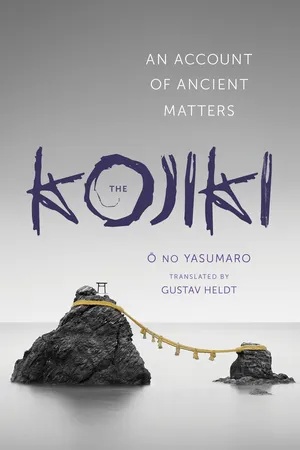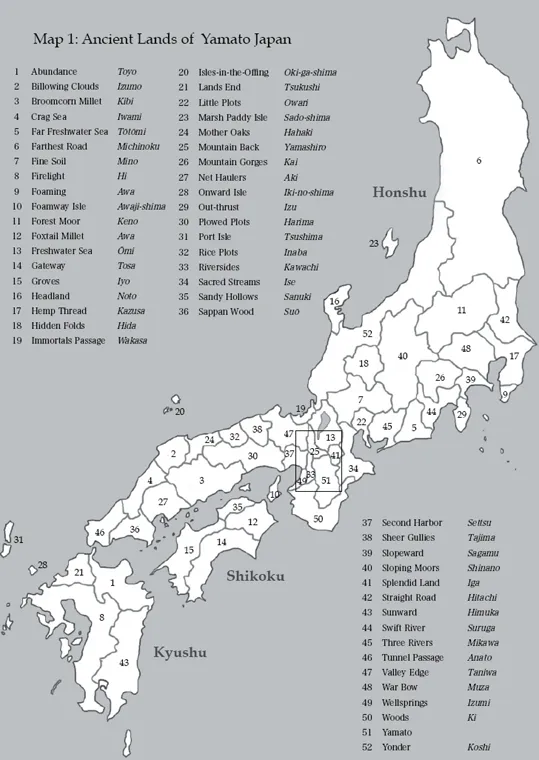
- English
- ePUB (mobile friendly)
- Available on iOS & Android
eBook - ePub
About this book
Japan's oldest surviving narrative, the eighth-century Kojiki, chronicles the mythical origins of its islands and their ruling dynasty through a diverse array of genealogies, tales, and songs that have helped to shape the modern nation's views of its ancient past. Gustav Heldt's engaging new translation of this revered classic aims to make the Kojiki accessible to contemporary readers while staying true to the distinctively dramatic and evocative appeal of the original's language. It conveys the rhythms that structure the Kojiki's animated style of storytelling and translates the names of its many people and places to clarify their significance within the narrative. An introduction, glossaries, maps, and bibliographies offer a wealth of additional information about Japan's earliest extant record of its history, literature, and religion.
Frequently asked questions
Yes, you can cancel anytime from the Subscription tab in your account settings on the Perlego website. Your subscription will stay active until the end of your current billing period. Learn how to cancel your subscription.
No, books cannot be downloaded as external files, such as PDFs, for use outside of Perlego. However, you can download books within the Perlego app for offline reading on mobile or tablet. Learn more here.
Perlego offers two plans: Essential and Complete
- Essential is ideal for learners and professionals who enjoy exploring a wide range of subjects. Access the Essential Library with 800,000+ trusted titles and best-sellers across business, personal growth, and the humanities. Includes unlimited reading time and Standard Read Aloud voice.
- Complete: Perfect for advanced learners and researchers needing full, unrestricted access. Unlock 1.4M+ books across hundreds of subjects, including academic and specialized titles. The Complete Plan also includes advanced features like Premium Read Aloud and Research Assistant.
We are an online textbook subscription service, where you can get access to an entire online library for less than the price of a single book per month. With over 1 million books across 1000+ topics, we’ve got you covered! Learn more here.
Look out for the read-aloud symbol on your next book to see if you can listen to it. The read-aloud tool reads text aloud for you, highlighting the text as it is being read. You can pause it, speed it up and slow it down. Learn more here.
Yes! You can use the Perlego app on both iOS or Android devices to read anytime, anywhere — even offline. Perfect for commutes or when you’re on the go.
Please note we cannot support devices running on iOS 13 and Android 7 or earlier. Learn more about using the app.
Please note we cannot support devices running on iOS 13 and Android 7 or earlier. Learn more about using the app.
Yes, you can access The Kojiki by no Yasumaro Ō, Gustav Heldt in PDF and/or ePUB format, as well as other popular books in Literature & Japanese History. We have over one million books available in our catalogue for you to explore.
Information

Map 2: Central Yamato

BIBLIOGRAPHY
IMPORTANT PRIMARY SOURCES FOR EARLY JAPANESE HISTORY
Chronicles of Japan (Nihon shoki, 720). The official historical chronicle of Japan’s first years, it was extensively annotated by later generations of court scholars. For a complete translation in English, see W. G. Aston, Nihongi: Chronicles of Japan from the Earliest Times to A.D. 697 (Rutland, Vt.: Tuttle Publishing, 1972).
Engi Rites (Engi shiki, c. 905–967). A compendium of court rituals, procedures, and offices that was compiled during the Engi era (901–923) and shortly thereafter. For an extensively annotated translation of the first ten books into English, see Felicia Bock, Engi-shiki: Procedures of the Engi Era, 2 vols. (Tokyo: Sophia University, 1970 and 1972).
Gazetteers (Fudoki, 713–733). Compendia of topography, tales, and natural resources compiled by provincial officials for the central administration, they have only survived in fragmentary form. For a complete annotated translation, see Michiko Y. Aoki, Records of Wind and Earth: A Translation of Fudoki with Introduction and Commentaries (Ann Arbor, Mich.: Association for Asian Studies, 1997).
Gleanings of Ancient Words (Kogo shūi, 807). A ninth-century compilation of myths and ritual procedures of the Taboo Handlers (see General Terms) compiled by a member of that clan named Imibe no Hironari. For a complete annotated translation into English, see Hoshino Hikoshirō and Genchi Katō, Kogoshūi: Gleanings from Ancient Stories (London: Curzon Press, 1926).
Hymns (Norito). Prayers recited for court rituals, their language infused both prose and poetry in early Japan. For an annotated translation into English, see Donald Phillipi, Norito: A Translation of the Ancient Japanese Ritual Prayers (Princeton: Princeton University Press, 1990).
Japanese Miracles (Nihon koku genpō zen’aku ryōiki, c. 787–824). More literally “Japanese Accounts of Good and Bad Karma in This Life Involving Spirits and Anomalies,” it is a collection of tales illustrating the workings of karma in Japan. For an annotated translation in English, see Kyōko Nakamura, Miraculous Tales from the Japanese Buddhist Tradition: The Nihon ryōiki of the Monk Kyōkai (Cambridge, Mass.: Harvard University Press, 1973).
Myriad Leaves Collection (Man’yōshū). A voluminous late eighth-century poetry anthology. There are two complete translations in English: Jan L. Pierson, The Manyōsū, 17 vols. (Leiden: E. J. Brill, 1929–1963); and H. H. Honda, The Manyoshu: A New and Complete Translation (Tokyo: Hokuseidō Press, 1967).
Revised Genealogies (Shinsen shōjiroku, 814–815). A compilation of genealogies, divided by category into spirits, royalty, and nobility. The last of these includes over a thousand clans inhabiting the central provinces of the capital region. Only portions of the original thirty chapters survive.
Wei Account (Wei zhi, 297). A section of the third-century Chinese historical chronicle Sanguo zhi (Records of Three Kingdoms) that gives the earliest description of Japan. For a complete translation and detailed study, see Edward J. Kidder, Himiko and Japan’s Elusive Chiefdom of Yamatai: Archaeology, History, and Mythology (Honolulu: University of Hawai’i Press, 2007).
ENGLISH-LANGUAGE TRANSLATIONS OF THE KOJIKI
Chamberlain, Basil Hall. The Kojiki: Records of Ancient Matters. Originally translated in 1882 and reissued by Tuttle Publishing from 1972 onward.
Danno, Yoko. Songs and Stories of the Kojiki. Toronto: Ahadada Books, 2008.
Inoue, Shunji. Kojiki. Tokyo: English Translation of the Kojiki Preparatory Association, 1965.
Isobe, Yaichiro. The Story of Ancient Japan or Tales from the Kojiki. Tokyo: San Kaku Sha, 1929.
Philippi, Donald. Kojiki. Tokyo: University of Tokyo Press, 1968.
JAPANESE MYTHOLOGY
Akima, Toshio. “The Myth of the Goddess of the Undersea World and the Tale of Empress Jingū’s Subjugation of Korea.” Japanese Journal of Religious Studies 20, nos. 2–3 (1993): 95–185.
Aoki, Michiko Y. Ancient Myths and Early History of Japan: A Cultural Foundation. New York: Exposition Press, 1974.
Carlqvist, Anders. “The Land-Pulling Myth and Some Aspects of Historical Reality.” Japanese Journal of Religious Studies 37, no. 2 (2010): 185–222.
deVeer, Henrietta. “Myth Sequences from the Kojiki: A Structural Study.” Japanese Journal of Religious Studies 3, nos. 2–3 (1976): 175–214.
Ellwood, Robert S. “A Japanese Mythic Trickster Figure: Susa-no-o.” In Mythical Trickster Figures: Contours, Contexts, and Criticism, ed. William J. Hynes and William G. Doty, 141–58. Tuscaloosa: University of Alabama Press, 1993.
——. “The Sujin Religious Revolution.” Japanese Journal of Religious Studies 17, nos. 2–3 (1990): 200–17.
Fairchild, William P. “‘Mika’-Jar Deities in Japanese Mythology.” Asian Folklore Studies 24, no. 1 (1965): 81–101.
Fuminobu, Murakami. “Incest and Rebirth in Kojiki.” Monumenta Nipponica 43, no. 4 (1988): 455–63.
Grayson, James H. “Susa-no-o: A Culture Hero from Korea.” Japan Forum 14, no. 3 (2002): 465–88.
Isomae Jun’ichi. Japanese Mythology: Hermeneutics on Scripture. London: Equinox Publishing, 2010.
——. “Myth in Metamorphosis: Ancient and Medieval Versions of the Yamatotakeru Legend.” Monumenta Nipponica 54, no. 3 (1999): 361–85.
Kawai, Hayao. “The Hollow Center in the Mythology of Kojiki.” Review of Japanese Culture and Society 1, no. 1 (1986): 72–77.
Keene, Donald. “The Kojiki as Literature.” Transactions of the Asiatic Society of Japan, 47 (1983): 99–132.
Kelsey, W. Michael. “The Raging Deity in Japanese Mythology.” Asian Folklore Studies 40, no. 2 (1981): 213–36.
Kōnoshi, Takamitsu. “Constructing Imperial Mythology: Kojiki and Nihon shoki.” In Inventing the Classics: Modernity, National Identity, and Japanese Literature, ed. Haruo Shirane and Tomi Suzuki, 51–67. Stanford: Stanford University Press, 2000.
——. “The Land of Yomi: On the Mythical World of the Kojiki.” Japanese Journal of Religious Studies 11, no. 1 (1984): 57–76.
Kurosawa, Kōzō. “Myths and Tale Literature.” Japanese Journal of Religious Studies 9, nos. 2–3 (1982): 115–25.
Littleton, C. Scott. “Yamato-takeru: An ‘Arthurian’ Hero in Japanese Tradition.” Asian Folklore Studies 54, no. 2 (1995): 259–74.
Matsu...
Table of contents
- Cover
- Series Page
- Title Page
- Copyright
- Dedication
- Contents
- Acknowledgments
- Introduction
- Preface
- Book One
- Book Two
- Book Three
- Glossary of General Terms
- Glossary of Personal Names
- Glossary of Place Names
- Map 1. Ancient Lands of Yamato Japan
- Map 2. Central Yamato
- Bibliography
- Translation